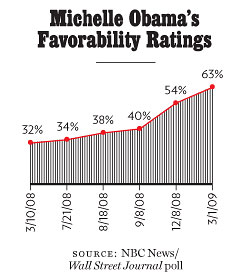
Aside from launching a sartorial revolution, what impact is Michelle likely to have in the unelected yet exceedingly public post she now occupies? For an answer, one need only look to the last job Michelle held before her husband’s political career engulfed their household: community-outreach director. At the University of Chicago Medical Center, her mandate was to improve relations between her employer and the economically struggling residents of surrounding neighborhoods, many of whom nursed decades-long grudges over their perceived mistreatment by the university.
Now Michelle is the de facto community-outreach director of the Obama administration. At first glance, her public schedule might appear haphazard—one day she’s greeting staffers at the EPA; another, she’s ladling out mushroom risotto at a D.C. soup kitchen; yet another, she’s giving area culinary students a tour of the White House kitchen. But there is a thematic thread running through these endeavors. The Obama team has pledged to be the most open, inclusive, communicative administration in modern history. Michelle’s mission is to sell that image by reaching out to a range of constituencies, including government workers (who took a beating under Bush) and the local citizenry (as the first African-Americans in the White House, the Obamas carry great expectations in the majority-black capital).

» The Meaning of an Icon» Her Body, Ourselves» Her Old-school Parenting» Her Father’s Daughter More Essays Why We Crave a Royal MichelleGood White House KeepingThe First Couple’s Sexual PoliticsFrom ‘Militant’ to ‘Princess’Extending the Obama BrandNormalizing the PresidentAbout FaceThe First Wives’ ClubLittle SisterThe Fashion QuestionThe Edible & PoliticalThat’s One Tall WomanWhy She Left Her Law FirmThe Suggestions in Her EyesMichelle: A LifeArtists’ Interpretations
Despite her spunky persona and trailblazing image, Michelle is operating in a largely ambassadorial role. Hers is to listen, learn, and spread glad tidings on behalf of her husband. Her focus may shift slightly as she homes in on a couple of pet projects. For instance, Michelle hopes to use her platform to address the issue of work-family balance, particularly as it relates to military families. (By focusing on the military, she avoids the trickier terrain of work-family balance as it affects the broader populace, with all of the culturally charged debates over who should look after our kids and what is government’s proper role in encouraging a family-friendly workplace. Better still, for Democrats, any wooing of the military is smart politics.) That’s not to say the First Lady will be spearheading a task force on military spouses. She has said that she has no interest in mucking around in policy minutiae, much less claiming a portfolio of her own.
Those close to Hillary Clinton say she was never comfortable with the symbolic nature of the First Lady’s job. Like any good sixties feminist, she wanted to effect change through direct action. Michelle, by contrast, seems content with an indirect approach—tinkering around the edges of a few nontoxic issues and serving as a behind-the-scenes counselor to her husband. (Although can we please retire the nauseating term “pillow talk”—as though the only place Barack listens to Michelle is snuggled under the covers?) Perhaps most important, Michelle seems to embrace the idea of being a symbol—of her family’s comforting conventionality, of the administration’s vaunted accessibility, of her husband’s attempts to “keep it real.” She recognizes that, by and large, this is what the job is all about.